LIS2DW12 and LIS2DH12, as two 3-axis MEMS accelerometers developed by STMicroelectronics, represent advanced motion sensing technology. Engineered to meet diverse application needs, from low power consumption to high precision, and incorporating advanced motion detection features, these sensors are at the forefront of innovation. This article delves deep into the technical specifications, feature disparities, and respective application domains of these sensors, providing engineers and developers with insights to choose the most suitable one for their project requirements.
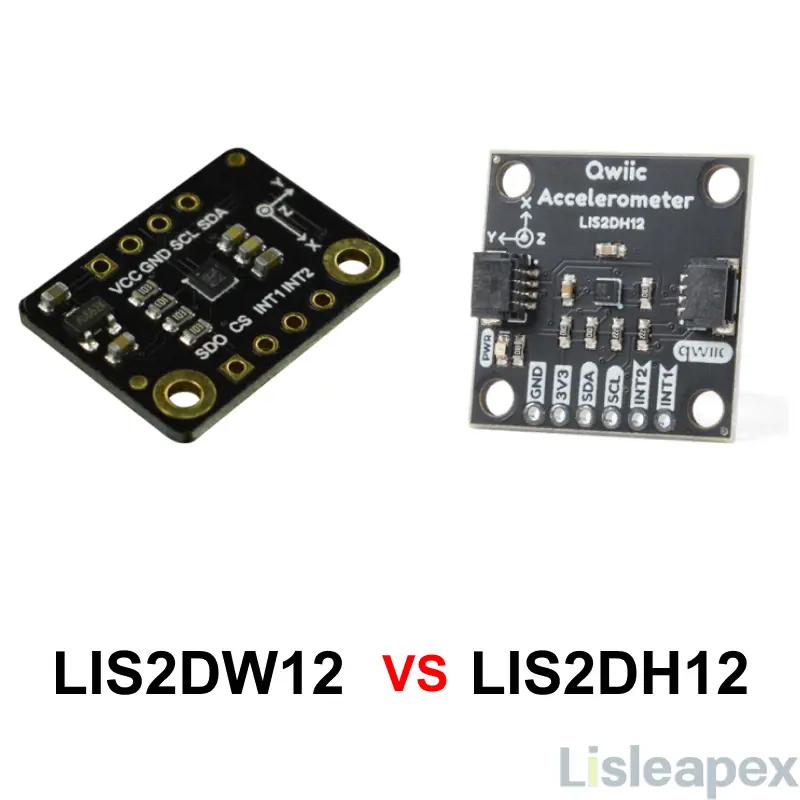
What is LIS2DW12
The LIS2DW12 is a 3-axis MEMS accelerometer developed by STMicroelectronics, designed to enable efficient motion sensing and advanced motion detection capabilities. It features ultra-low power consumption, making it suitable for applications requiring prolonged operation and low energy consumption, such as wearables and IoT devices. The accelerometer supports a selectable measurement range of ±2 to ±16 g, catering to dynamic environments in various applications.
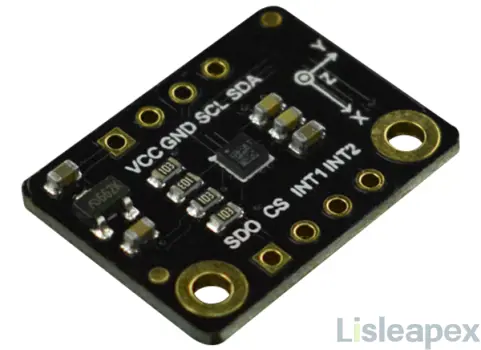
Furthermore, the LIS2DW12 incorporates a built-in pedometer and step counter, making it an ideal choice for health tracking and activity monitoring applications. With a flexible output data rate of up to 6.66 kHz, it provides rich data information, making it suitable for scenarios sensitive to high-frequency motion changes, such as gesture recognition and game control.
In summary, the LIS2DW12, with its comprehensive feature set, offers precise and efficient motion sensing capabilities for a variety of mobile and smart devices, playing a crucial role in areas such as IoT, wearable technology, and health monitoring.
What is LIS2DH12
The LIS2DH12 is a 3-axis MEMS accelerometer developed by STMicroelectronics, engineered to facilitate accurate motion sensing in diverse applications. Known for its versatility, this sensor offers a selectable measurement range of ±2 to ±16 g, catering to a wide range of scenarios where precise acceleration measurements are crucial.
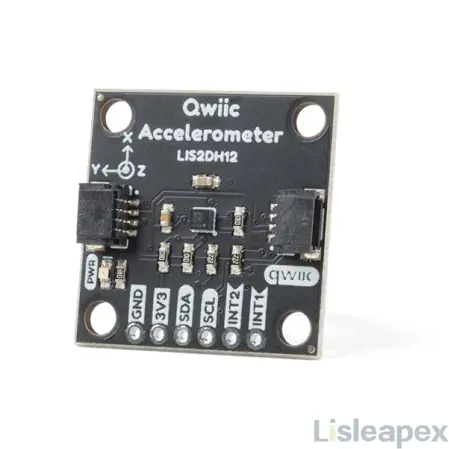
With a compact design and operating across a broad temperature range (-40 °C to +85 °C), the LIS2DH12 is well-suited for integration into various electronic devices. Its power-efficient design, consuming less than 100 μA in normal mode, makes it suitable for battery-powered applications, contributing to extended device lifetimes.
The LIS2DH12 supports both I2C and SPI communication interfaces, providing flexibility for integration into different microcontroller-based systems. It is a reliable choice for applications requiring motion-activated features, display orientation adjustments, and impact recognition, making it a fundamental component in the development of motion-sensitive technologies.
LIS2DW12 vs LIS2DH12: Specifications
The LIS2DW12 and LIS2DH12 are accelerometers with similar measurement ranges of ±2, ±4, ±8, or ±16 g and a maximum output data rate of 6.66 kHz. However, the LIS2DW12 exhibits lower noise density at 90 µg/√Hz compared to the LIS2DH12's 150 µg/√Hz. The LIS2DH12 has a wider voltage range of 1.71V to 3.6V, while the LIS2DW12's voltage range is 1.62V to 3.6V. Additionally, the LIS2DW12 boasts higher shock survivability at 10,000 g, whereas the LIS2DH12 has a shock survivability of 2,000 g.
|
Technical Specifications |
LIS2DW12 |
LIS2DH12 |
|
Maximum Supply Voltage (Vsup) |
3.6 V |
3.6 V |
|
Minimum Supply Voltage (Vsup) |
1.62 V |
1.71 V |
|
Terminal Pitch |
0.5 mm |
0.5 mm |
|
Noise Density |
90 µg/√Hz |
150 µg/√Hz |
|
Measurement Range |
±2, ±4, ±8, or ±16 g |
±2, ±4, ±8, or ±16 g |
|
Output Data Rate |
6.66 kHz |
6.66 kHz |
|
Shock Survivability |
10,000 g |
2,000 g |
LIS2DW12 vs LIS2DH12: Pinout
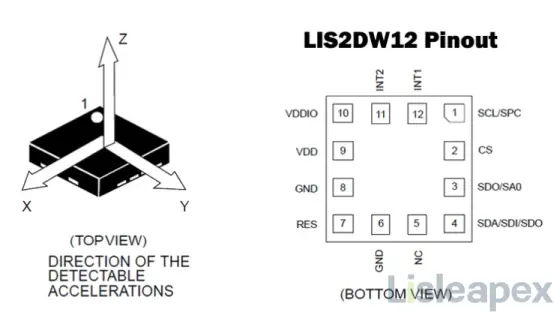
LIS2DW12 pinout
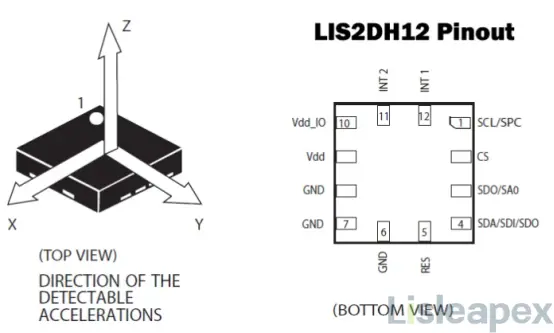
LIS2DH12 pinout
Both the LIS2DW12 and LIS2DH12 accelerometers are available in versatile 12-lead and 16-lead plastic LGA packages. Their pin configurations exhibit notable similarities, providing flexibility in integration and functionality:
Interrupt Outputs (INT1 and INT2 - Pins 1 and 2):
Function: Dedicated interrupt output pins.
Ground Connection (GND - Pin 3):
Purpose: Common ground connection for both devices.
Power Supply Input (VDD - Pin 4):
Voltage Range: Accepts power supply voltages within the range of 1.71V to 3.6V.
SPI Communication Control (CS - Pin 5):
Usage: Chip select for SPI communication (optional in I2C mode).
Serial Clock Input (SCL/SPC - Pin 6):
Role: Serves as the serial clock for I2C or as the serial peripheral input for SPI communication.
Data Input/Output (SDA/SDI/SDO - Pin 7):
Role: Handles serial data input/output for I2C/SPI communication.
Despite the shared functionalities, specific pin differences require attention:
Pin 8:
LIS2DW12: Designated as No Connection (NC), offering flexibility based on design needs.
LIS2DH12: Labeled as (Res) and requires a connection to Ground.
Data I/O (Pin 9):
Utilized for data input/output, depending on the chosen I2C or SPI protocol.
Interrupt Pins (INT1, INT2):
These pins serve analogous purposes in both sensors, with the exception of INT1 in LISDHW, which also functions as a Clock input in single conversion mode.
LIS2DW12 vs LIS2DH12: Block Diagram
The LIS2DW12 and LIS2DH12 accelerometers feature analogous block diagrams, encompassing essential components such as an Analog Front-End (AFE), a Digital Signal Processor (DSP), and an I2C/SPI interface.
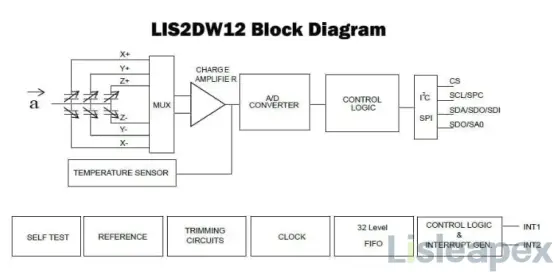
LIS2DW12 Block Diagram
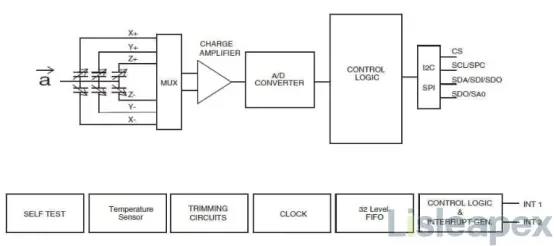
LIS2DH12 Block Diagram
LIS2DW12 vs LIS2DH12: Features
Power Consumption:
Both accelerometers exhibit low power consumption characteristics. The LIS2DW12 operates with a power consumption of less than 50 μA in low-power mode, while the LIS2DH12 consumes less than 100 μA in its normal mode.
Built-in Pedometer and Step Counter:
The LIS2DW12 incorporates a built-in pedometer and step counter, augmenting its suitability for wearable devices and motion detection applications. This feature enhances its capability to accurately track steps and movement.
High Resolution:
In terms of resolution, the LIS2DH12 boasts a high precision of 16 bits. This elevated resolution enables more accurate and detailed measurements, contributing to its efficacy in scenarios where precision is paramount.
Communication Interfaces:
Both accelerometers support multiple communication interfaces, including I2C and SPI, providing flexibility in integrating with various microcontrollers and systems.
Measurement Range:
Both sensors offer a selectable measurement range of ±2, ±4, ±8, or ±16 g, allowing adaptability to different application requirements. This versatility makes them suitable for a wide range of motion sensing scenarios.
Interrupt Functionality:
The LIS2DW12 and LIS2DH12 are equipped with interrupt pins (INT1 and INT2), enabling the implementation of interrupt-based functionalities for responsive and event-driven applications.
LIS2DW12 vs LIS2DH12: Application
LIS2DW12 Applications:
- Motion Detection in Wearables: LIS2DW12 excels in wearables, providing precise motion detection for enhanced user experience and activity tracking.
- Gesture Recognition and Gaming: Its capabilities make it ideal for gesture recognition and gaming applications, enhancing interaction and responsiveness.
- Motion-Activated Functions and User Interfaces: LIS2DW12 is well-suited for implementing motion-activated features in user interfaces, contributing to intuitive device control.
- Display Orientation: Specifically designed for display orientation applications, ensuring seamless transitions based on device positioning.
- Tap/Double-Tap Recognition: Efficient in recognizing taps and double-taps, offering versatility in user input and control.
- Free-Fall Detection: Incorporates free-fall detection, enhancing safety features in devices by recognizing free-fall conditions.
- Smart Power Saving for Handheld Devices: Optimized for power efficiency, making it a suitable choice for handheld devices where smart power-saving features are crucial.
LIS2DH12 Applications:
- Motion-Activated Functions: LIS2DH12 is tailored for applications requiring motion-activated features, contributing to energy-efficient device operation.
- Display Orientation: Well-suited for display orientation tasks, ensuring seamless adjustments based on device positioning.
- Shake Control: Designed to support shake control applications, providing precise sensing for controlled device actions.
- Pedometer: Ideal for pedometer applications, accurately tracking step counts in fitness and health-related devices.
- Gaming and Virtual Reality Input Devices: LIS2DH12 is a preferred choice for gaming peripherals and virtual reality input devices, delivering responsive motion sensing.
- Impact Recognition and Logging: Its robust shock survivability makes it suitable for impact recognition and logging applications, particularly in industrial settings.
In summary, the LIS2DW12 and LIS2DH12 cater to specific application niches, with LIS2DW12 excelling in wearables, user interfaces, and smart power-saving contexts, while LIS2DH12 stands out in gaming peripherals, pedometers, and industrial applications requiring impact recognition.
LIS2DW12 vs LIS2DH12: Package Outline
LIS2DH12:
Length (L): 2.00 mm (±0.15)
Width (W): 2.00 mm (±0.15)
Height (H): 1.0 mm (Maximum)
LIS2DW12:
Length (L): 2.00 mm (±0.1)
Width (W): 2.00 mm (±0.1)
Height (H): 0.7 mm (Maximum)
Dimensional Analysis:
- Length (L): Both accelerometers share a similar length of 2.00 mm, with a slight variation in tolerance.
- Width (W): The width for both is consistent at 2.00 mm, with a slight variation in tolerance.
- Height (H): The LIS2DW12 is marginally shorter with a maximum height of 0.7 mm, compared to the LIS2DH12's maximum height of 1.0 mm.
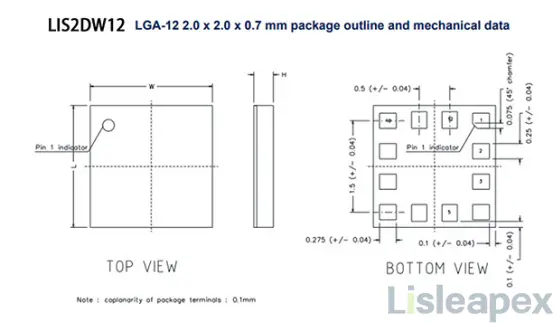
LIS2DW12 Package
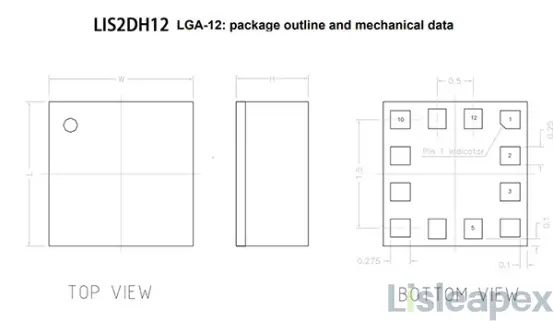
LIS2DH12 package
LIS2DW12 vs LIS2DH12: Price
In terms of pricing from RS Components for a quantity of 50 units, the LIS2DW12 is notably more expensive compared to the LIS2DH12 and other mentioned accelerometers. While the LIS2DW12 offers distinct features, including low power consumption, the cost difference may influence the choice between the two accelerometers based on budget considerations and specific application requirements.
For updated price, visit lisleapex to get it.
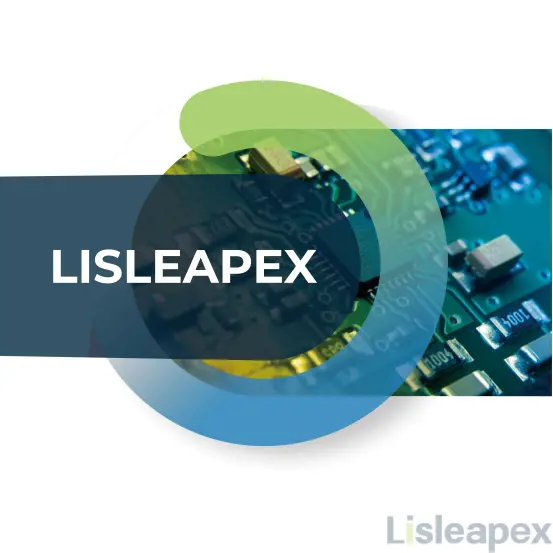
Lisleapex Electronics welcomes you to explore the forefront of innovative solutions tailored to meet your electronic sensing and detection needs. As a pioneering company committed to excellence, Lisleapex takes pride in offering cutting-edge technology and reliable performance across our product range. Whether you're delving into motion detection, sensor integration, or seeking advanced electronic solutions, we invite you to inquire and discover how Lisleapex Electronics can elevate your projects.
LIS2DW12 vs LIS2DH12: Electrical Connection Circuit
The core power supply for both the LIS2DW12 and LIS2DH12 devices is provided through the Vdd line, whereas the I/O pads receive power via the Vdd_IO line. To ensure optimal performance and reduce potential noise, it is recommended to incorporate power supply decoupling capacitors (consisting of a 100 nF ceramic capacitor and a 10 μF aluminum capacitor) positioned in close proximity to pin 9 of the device, aligning with established design practices.
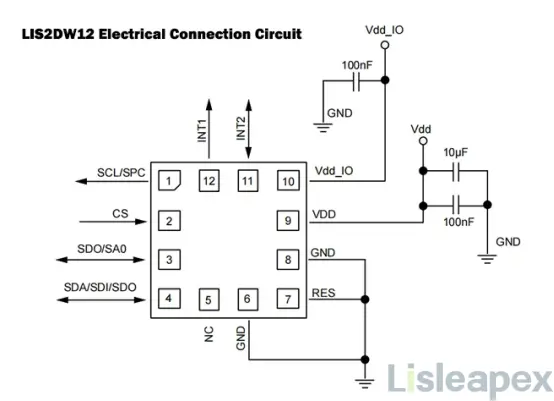
LIS2DW12 Electrical Connection Circuit
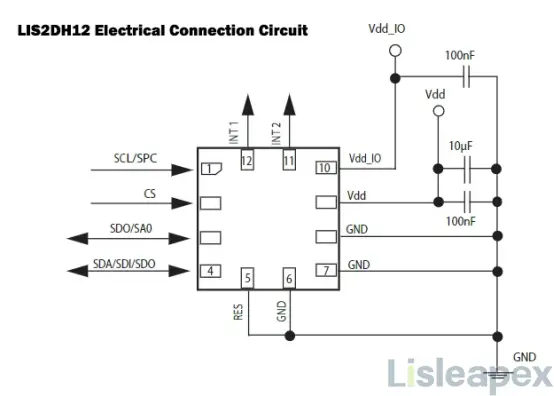
LIS2DH12 Electrical Connection Circuit
LIS2DW12 vs LIS2DH12: Alternative Part
Alternative Components for LIS2DW12:
💎 LIS2DWLTR:
The LIS2DWLTR is a functional alternative with similar motion-sensing capabilities as the LIS2DW12. It shares a comparable form factor, making it an excellent replacement for applications requiring precise motion detection.
💎 LIS2DW12TR:
Specifically designed for certain applications, the LIS2DW12TR maintains the key features of the LIS2DW12 while introducing nuanced characteristics tailored to unique operational demands.
💎 LIS2DW12P:
The LIS2DW12P variant is optimized to enhance specific aspects of performance, offering tailored solutions for applications with distinct requirements. It maintains compatibility with the LIS2DW12 platform.
Alternative Components for LIS2DH12:
💎 LIS2DH12TR:
The LIS2DH12TR serves as a reliable alternative to the LIS2DH12, offering similar motion-sensing capabilities. It is tailored to specific applications, providing distinct attributes while maintaining compatibility.
💎 LIS2DH12P:
The LIS2DH12P variant is engineered for applications with unique specifications, introducing variations to enhance performance in specific operational scenarios. It remains compatible with the LIS2DH12 platform.
💎 LIS2DH12D:
The LIS2DH12D is an alternative model designed to address particular considerations, making it suitable for applications with varied requirements. It ensures compatibility while offering nuanced operational features.
Advantages and Disadvantages between LIS2DW12 and LIS2DH12
|
Feature |
LIS2DW12 |
LIS2DH12 |
|
Power Consumption |
Lower |
Higher |
|
Size/Form Factor |
Compact (Max Height: 0.7 mm) |
Slightly Larger (Max Height: 1.0 mm) |
|
Shock Survivability |
Lower (10,000 g) |
Higher (2,000 g) |
|
Resolution |
Standard (Not specified, likely 12 bits) |
Higher (16 bits) |
|
Built-in Pedometer |
Yes |
No |
|
Versatility in Applications |
Wearables, Low Power Applications |
General Motion Sensing, Industrial Applications |
|
Cost (Based on provided prices) |
Relatively Lower |
Relatively Higher |
LIS2DW12 vs LIS2DH12: Which is Better and How t o Choose(datasheet included)
Both the LIS2DW12 and LIS2DH12, crafted by STMicroelectronics, are 3-axis MEMS accelerometers. A brief comparison is outlined below:
Power Consumption:
LIS2DW12 boasts an ultra-low-power design, consuming less than 1 μA in low-power mode, rendering it optimal for battery-powered or energy-sensitive applications.
Performance:
LIS2DW12 offers lower noise levels (down to 90 μg/√Hz) compared to LIS2DH12, ensuring enhanced precision in measurements.
Data Output Rate:
The LIS2DW12 provides a more flexible data output rate, ranging from 1.6 Hz up to 1600 Hz, offering adaptability to varying application needs.
Motion Detection Features:
The LIS2DW12 is equipped with a dedicated internal engine that facilitates advanced motion detection capabilities, including free-fall detection, wakeup detection, single/double-tap recognition, and activity/inactivity detection. This may represent an advancement compared to the features available in the older model, LIS2DH12.
Temperature Range:
Both sensors operate seamlessly over a wide temperature range (-40 °C to +85 °C), ensuring reliability across diverse environmental conditions.
Relevant Parameters for Accelerometer Selection:
- Package Noise
- Resolution
- Full Scale (Low and High-g)
- Zero-g Level Accuracy
- Power Consumption
- Output Data Rate
- Filters and Bandwidth
In Summary:
If your priorities include ultra-low power consumption, advanced motion detection features, and improved performance with lower noise levels, the newer model, LIS2DW12, is the preferred choice.
Manufacturer
STMicroelectronics, established in 1987 through the merger of SGS Microelettronica and Thomson Semiconducteurs, stands as a global leader in the semiconductor industry. Headquartered in Geneva, Switzerland, the company is renowned for its extensive portfolio of integrated circuits, microcontrollers, and MEMS sensors. With a commitment to innovation and sustainability, STMicroelectronics plays a pivotal role in shaping advancements across diverse sectors, including automotive, industrial, and personal electronics, contributing to the evolution of technology on a global scale.
STMicroelectronics, a powerhouse in the semiconductor arena since its formation in 1987, has become synonymous with cutting-edge technological solutions. Operating on a global scale and headquartered in Geneva, Switzerland, the company specializes in developing and manufacturing a comprehensive range of semiconductor products, from microcontrollers and analog ICs to MEMS sensors. Renowned for its commitment to research, innovation, and sustainability, STMicroelectronics continues to be a key player driving progress across industries, catering to the ever-evolving demands of the digital age.
Conclusion
In summary, LIS2DW12 and LIS2DH12 stand as notable contributions from STMicroelectronics in the realm of MEMS accelerometers. They excel in areas of low power consumption, high precision, and advanced motion detection, each showcasing its distinct advantages. Whether utilized in wearables, smart IoT applications, or industrial settings, these sensors offer flexible and reliable solutions. In the rapidly evolving landscape of electronic technology, understanding and selecting sensors that align with specific application needs is a pivotal step in ensuring the success of any project.
FAQ
-
Can LIS2DW12 and LIS2DH12 be used for tilt sensing or orientation detection?
Yes, these accelerometers can be used for tilt sensing and orientation detection based on the changes in acceleration they detect.
-
Are there evaluation boards available for LIS2DW12 and LIS2DH12?
Yes, STMicroelectronics often provides evaluation boards and development kits for their sensors, including LIS2DW12 and LIS2DH12, to aid in the development and testing of applications.
-
Can LIS2DW12 and LIS2DH12 be used in battery-powered devices?
Yes, these sensors are designed to be power-efficient and can be used in battery-powered applications.
-
What is the communication interface used by LIS2DW12 and LIS2DH12?
Both sensors typically use an I2C (Inter-Integrated Circuit) or SPI (Serial Peripheral Interface) communication interface for interfacing with microcontrollers or other devices.
-
How are LIS2DW12 and LIS2DH12 typically used?
These sensors are commonly used in various applications, including mobile devices, wearables, Internet of Things (IoT) devices, and other systems where measuring acceleration is essential.
-
Are LIS2DW12 and LIS2DH12 digital sensors?
Yes, both LIS2DW12 and LIS2DH12 are digital accelerometers, meaning they provide digital output that can be read and processed by a microcontroller or other digital devices.
Stay updated with Lisleapex by signing up for the newsletter


 Congratulations On Your Successful Submission
Congratulations On Your Successful Submission
 Submission Failure
Submission Failure
